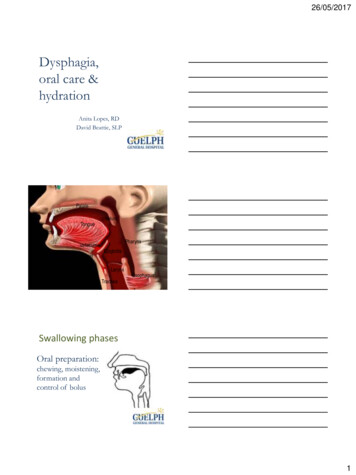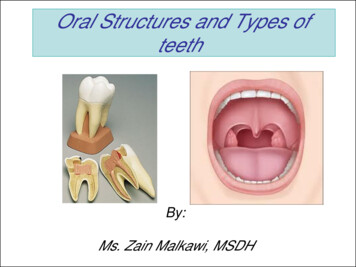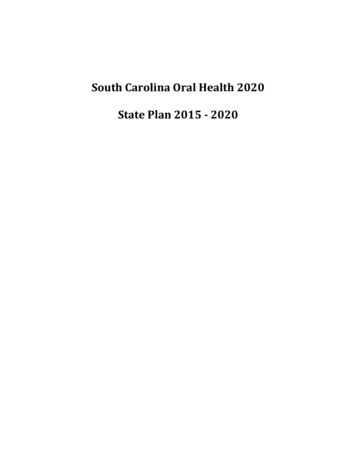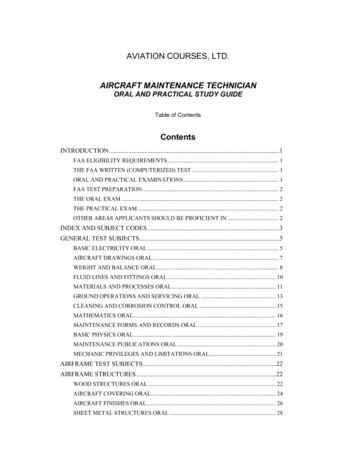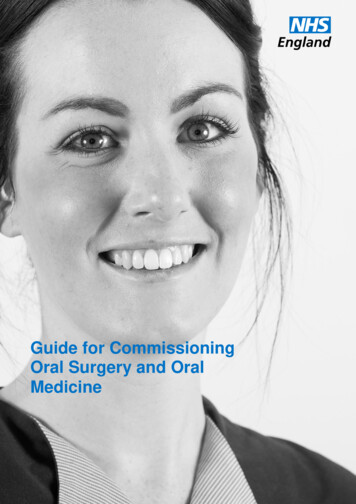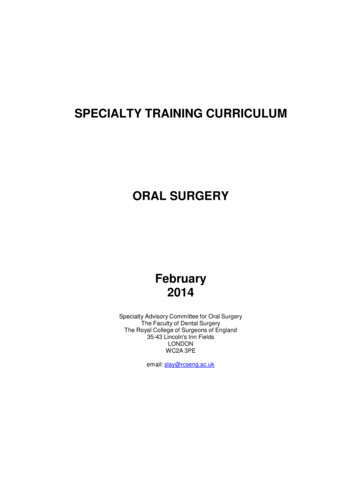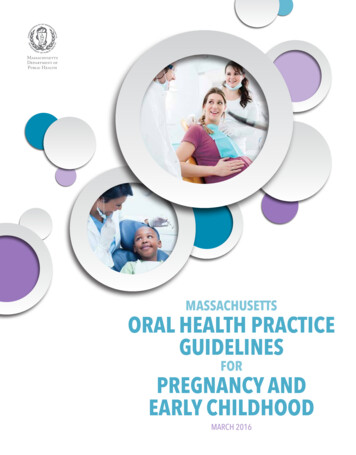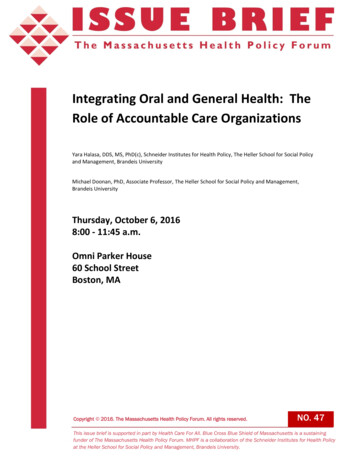
Transcription
Integrating Oral and General Health: TheRole of Accountable Care OrganizationsYara Halasa, DDS, MS, PhD(c), Schneider Institutes for Health Policy, The Heller School for Social Policyand Management, Brandeis UniversityMichael Doonan, PhD, Associate Professor, The Heller School for Social Policy and Management,Brandeis UniversityThursday, October 6, 20168:00 - 11:45 a.m.Omni Parker House60 School StreetBoston, MACopyright 2016. The Massachusetts Health Policy Forum. All rights reserved.NO. 471This issue brief is supported in part by Health Care For All. Blue Cross Blue Shield of Massachusetts is a sustainingfunder of The Massachusetts Health Policy Forum. MHPF is a collaboration of the Schneider Institutes for Health Policyat the Heller School for Social Policy and Management, Brandeis University.
ContentsAcknowledgements. 3Executive Summary. 3Introduction . 7Section One: Disconnect of Oral and the General Health Care System. 8Oral health delivery system . 9Oral health insurance system . 10Financing structure . 11Coverage . 12Benefits associated with integrating oral into overall health . 12Section Two: Oral and General Health Integration Models . 13Approaches for oral and general health integration . 13Facilitated referral and follow-up . 13Virtual integration . 13Shared financing . 14Co-location . 14Full integration . 14Oral and general health integration models . 17Section Three: The Potential Role of ACOs . 21Accountable Care Organizations and oral and general health integration . 21Strategies and challenges to oral and general health integration through ACOs . 23Dental coverage innovation . 23Focus on primary care and adequate coordination channels between dental and medical providers . 25Providers’ outreach and education activities . 27Beneficiaries’ outreach and awareness . 27Integrated health records . 28Payment arrangement and risk sharing and providers incentives for providers . 29Quality measures . 30Section Four: Recommendations . 31References . 342
AcknowledgementsWe thank our colleagues Brian Rosman, Helen Hendrickson, Kelly Vitzthum, Neetu Singh, DMD, MPH atHealth Care For All for their contributions to the development of the issue brief and forum. We alsoextend our thanks to Marko Vujicic, PhD, American Dental Association; Marty Dellapenna, MSDA; DavidM. Leader, D.M.D., M.P.H., Tufts University; Michelle Dalal, MD; Hugh Silk, MD, MPH; and MichaelMonopoli, DMD, MPH, MS for their comments. Lastly, thank you to Clare Hurley from the Heller Schooland Ashley Brooks from the Massachusetts Health Policy Forum for their careful edits.Executive SummaryUnlike dental care, which is the responsibility of dental providers, oral health care is broader and shouldbe owned by all health providers regardless of discipline. The current environment, in which oral healthis seen as a separate, stand-alone healthcare entity, does not foster comprehensive quality care.Evidence shows that oral health complications, such as infections that begin in the mouth, can travelthroughout the body and lead to major health complications, even death. In parallel, a dental exam mayreveal signs of general health problems, such as nutritional deficiencies and systemic diseases, includingmicrobial infections, immune disorders, injuries, and some cancers. Furthermore, poor oral health isassociated with a number of social ills, including limited active engagement in society, loss ofproductivity, school absenteeism, in addition to inappropriate emergency department use, underemployment and unemployment, and has an adverse effect on military readiness.The Affordable Care Act (ACA) offers an opportunity for innovations in the health care delivery systemsand calls for a holistic approach to population healthcare. By testing value-based payment models, theACA is encouraging changes in medical care delivery systems and financing to ensure and maintainwellness across healthcare domains. These models work by pooling financial risk among a widespectrum of health care providers. This is an opportunity to move towards an integrated oral andgeneral health system.With nearly 24% of Massachusetts’ residents enrolled in Massachusetts’ Medicaid program, MassHealth,Medicaid plays a major role in providing care for Massachusetts’ most vulnerable populations. In April2016, Massachusetts Secretary of Health and Human Services proposed standards for a MassHealth3
accountable care organization program, which seeks to better integrate the health care delivery systemto provide more efficient care. A pilot program is expected to begin in December 2016, and the fullprogram is expected to begin October 2017. This report aims to explore how Massachusetts can takeadvantage of this reform to better coordinate oral into overall health, and thereby enhance patient care,improve health, and reduce costs.An Accountable Care Organization (ACO) is an organization of providers responsible for the overall careof enrollees. It provides a platform to bring together health providers to collaborate and improvehealthcare delivery, increase patient satisfaction, and reduce cost. Primary care is the core of ACOs, andintegrated case management has the potential to provide more appropriate and timely care and reduceduplication of services and medical errors.Successful strategies for integrating oral health into overall health require a new vision and approach tothe health care delivery system. Insurance coverage is a major factor in integrating what are, currently,distinct systems. ACOs serving the Medicaid population are more likely to offer dental services. Theinclusion of adult dental benefits as a core component of the Medicaid is invaluable for successful oralgeneral health integration. Provider outreach and educational activities are needed to fill theawareness and culture gap between dental and other health care providers. An increase in Medicaidbeneficiaries’ awareness of dental benefits, in addition to access to oral health care providers, isessential for overall health and well-being.Several approaches have been used to reach this goal. For example, using a team of outreach andreferral staff, Delta Dental of Iowa targets patients seeking care at emergency departments (ED) fordental pain, as does Trillium Coordinated Care Organization in Oregon. Innovative approaches are alsobeing used to incentivize members’ good oral health practices by establishing a dental home to promotecare continuity. Hennepin Health in Minnesota uses a team consisting of a community health worker, anRN clinical coordinator, and a social worker to help enroll new members, identify their health needs, andcoordinate health care visits. Adequate coordination between dental and other medical providers and aunified information and health record system that includes both medical and dental information isessential for effective coordination of care.In general, improving reimbursement rates and reducing administrative burdens will encourage moredentists to participate in the Medicaid program. ACOs can enhance access to dentists by offering4
incentives to dental providers for meeting certain requirements, such as completion of online riskassessments, proactive outreach for patients to encourage recall visits, and care maintenance.Coordinating overall health requires improving coverage of dental services and access to dental services,especially for those with publicly funded health insurance. It requires closing gaps in oral health literacyand changing the perceived low value of oral health among beneficiaries and primary care providers.Access challenges include limited provider access among Medicaid beneficiaries, as well astransportation, daycare and work-related conflicts. Another challenge is sharing electronic medicalrecords. Dental practices are not set up to share data and often use a mix of electronic health recordsand paper records. Finally, there is a lack of unified, standardized quality measures to evaluate theperformance of dental providers, making it difficult to link payment to performance.The experience from early Medicaid ACOs shows that while ACO’s leadership is committed to a holistichealth approach, oral health integration is often missing as other priorities take center stage. The slowintegration of oral and general health is a lost opportunity to improve overall patient health. While someeffort to promote coordinated care through patient-centered health homes and ACOs is taking placenationwide, these efforts are often pursued separately. No one model for oral health integration canmeet all needs of a diverse population, nor will it work for every organization. Regardless of theintegration model, a number of core principles remain necessary:1. Involve the dental community in ACO’s activities and invite a dental representative toparticipate on the ACO’s board.2. Improve access to dental care and the coverage of dental services, particularly in the Medicaidprogram.3. Facilitate debate to reach consensus on oral health quality measures that meet the approval ofpayers, providers, and patients.4. Invest in dental diagnostic codes and dental quality metrics to enable quality-based payment.5. Move away from the existing fee-for-service to a more value-based, integrated patient-centricfinancial model.6. Provide adequate incentives for providers to adopt integrated electronic health record (EHR)systems.7. Incentivized primary care providers to take an active role in oral health, i.e., conduct oral healthassessments and needs.5
8. Reform/modify health professional’s education to assure that providers can deliver trulyintegrated and comprehensive health care.9. Conduct more research and pilot studies to better explore best models for oral systemic healthintegration.6
IntroductionMrs. Dream received a phone call from her health coordinator, Mr. Iamhereforyou, who works at herprimary health care provider’s clinic, Clinic from Heaven, to inform her that her diabetes medicine refillwill arrive at her apartment before her current supply ends. The coordinator scheduled an appointmentwith her primary health care provider, the lab, and a nutritionist for the next day to check her bloodsugar and address any concerns she might have. Before concluding the call, Mr. Iamhereforyou informedMrs. Dream that her dental records showed that she last visited her dentist for periodontal treatmentthree months ago and that she needed to follow up with her treatment. “What day works best for Mrs.Dream to schedule the dental appointment,” Mr. Iamhereforyou asks.Unlike Mrs. Dream, Mrs. Reality is having a difficult time controlling her blood sugar. She finds that she isunable to get an appointment for weeks to see her primary health care provider. She leaves a messageon the voice machine of her provider’s office asking to refill her medications. She frequently uses the localhospital’s emergency department for a preventable condition associated with her diabetes and dentalpain. She has severe periodontal disease, and as a result lost some of her teeth. This affects her quality oflife and living standards. She feels unable to leave her low-paying job for a better one due to her oralhealth and the perceived unease others feel around her. She is trying to get dental care but Medicaid cutadult dental benefits and no dentist is willing to see her due to low reimbursement rates and spottycoverage. Her periodontal infection impedes her ability to control her blood sugar levels. As a result, shehas more inpatient episodes, frequent emergency department visits for oral pain, and declining overallhealth.While much is being done in Massachusetts to better coordinate care, oral health care is often left outof the discussion, leading to poorer health and higher health care costs. In addition to the pain andsuffering, poor oral health has social and economic consequences. For example, low income adults avoidsmiling (36%), and experience reduced participation in work and social activities due to the condition oftheir mouth and teeth [1]. The Massachusetts Health Policy Commission report found that 1 in 5individuals have unmet dental care needs due to cost, adults account for 90% of preventable oral healthemergency department visits, and MassHealth paid 48.8% of all oral health emergency department visits[2].7
Massachusetts’ cost containment reforms and the ACA encourages the transformation of health caredelivery systems toward a holistic approach to population healthcare. By testing and experimenting withvalue-based payment models, these reforms encourage changes in the medical care delivery systemsand financing by pooling the financial risk among multiple providers, representing a wider spectrum ofhealth care providers to ensure holistic population health. This new vision of the health care deliverysystem is an opportunity to put the mouth back in the body and to acknowledge the importance of oralhealth to overall health and wellbeing [3]. Nearly 24% of Massachusetts’ residents are enrolled inMassHealth [4], which plays a major role in providing care for Massachusetts’ most vulnerablepopulations. In April 2016, the Massachusetts Secretary of Health and Human Services proposed amajor reform to overhaul MassHealth [5]. This reform centers on a new integrated delivery system,known as the MassHealth Accountable Care Organization (ACO) Program. A pilot is expected to begin inDecember 2016, with the full program expected to begin October 2017. There are a number of waysMassachusetts can take advantage of this reform to better integrate oral health into overall health,enhance patients’ experience of care, improve the health of the population, and reduce the per capitacost of healthcare [6].This report is divided into four sections. The first section outlines evidence on the benefit of linking oralhealth to overall health, examines the challenges of the current oral health delivery system, and theconsequences of separating oral health from general health care delivery systems. In the secondsection, we examine oral and general health care integration models and the evolution of the ACOs,including Medicaid ACOs. We examine the proposed MassHealth ACO program, and how the currentproposal may enhance the delivery of oral health services. The third section analyses the current statusof oral and general health integration in ACOs and highlights examples from five states with MedicaidACOs that covers oral health for all or part of the Medicaid population. This section concludes byhighlighting successful strategies and challenges to integrating oral health into ACOs. The fourth sectionrecommends steps to providing greater access to more efficient integrated healthcare.Section One: Disconnect of Oral and the General Health CareSystemUnlike dental care, which is the responsibility of dental providers, oral health is broader and should beowned by all health providers regardless of their disciplines [7]. Our separate, stand-alone dentalhealthcare system does not foster comprehensive quality health care. The linkage between oral and8
overall health and well-being is well established [7]. An oral examination can reveal signs of numerousgeneral health problems, such as nutritional deficiencies and systemic diseases [7-9], including microbialinfections [10], immune disorders [11, 12], injuries [13, 14], and some cancers [15, 16]. Evidence showsthat oral health infections that begin in the mouth may travel throughout the body initiating andexacerbating general health conditions and could lead to death [17-19]. For example, periodontalbacteria have been found in samples removed from brain abscesses [20], pulmonary tissues [21], andcardiovascular tissues [22]. Periodontal disease may also be associated with adverse pregnancyoutcomes [23-28], respiratory disease [29-32], cardiovascular disease [33-37], coronary heart disease[38], and diabetes [39-42]. It is also true that chronic diseases and medications can exacerbate oralhealth problems [43]. Further, poor oral health is associated with a number of social ills, includinglimited active engagement in society [44], loss of productivity [45], school absenteeism [46-49],inappropriate emergency department use [2, 50, 51], under-employment and unemployment [52-54],and reduced military readiness [55].Despite evidence, oral health has been perceived as less important and disconnected from the rest ofthe body. In 2000, the US Surgeon General reported on the status of oral health, stressing that oralhealth is vital to general health and is especially responsive to preventive strategies [7, 56]. However,sixteen years after the Surgeon General’s report, oral health continues to be a distant component ofoverall health, and millions of Americans go without dental care each year.The disconnect between oral and overall health is multifactorial, as evidenced by the exclusion of oralhealth from health policy debates and the public perception that oral health is less important andseparate from general health [56]. The disconnection is also apparent in the separation of healthprofessional education and training systems, the oral health care delivery system, insurance system,financing structure, and coverage. The next section will detail the causes and current status of eachfactor.Oral health delivery systemThe separation between oral and medical care systems begins with separate education systems andprofessional cultures. Currently, oral health care is delivered through two fragmented models: privatepractice and the oral safety net, primarily Federally Qualified Health Centers (FQHC). The two modelsuse different financing systems, serve different clientele, and provide care in different settings [57]. Thedental delivery system is different from the medical system, with 69% of US private practice dentists9
operating in a solo practice versus only 18% of physicians [58]. They have autonomy in their practicedecisions and are better represented in urban and high-income areas [59, 60]. In Massachusetts, thisstructure resulted in 61 Dental Health Professional Shortage Areas (DHPSAs)1, mainly in ruralMassachusetts [2, 61, 62]. On average, 64% of patients in the Commonwealth have private dentalcoverage, 29% do not have any dental coverage, and 7% have publicly supported dental coverage [63].In Massachusetts, community health centers offer dental services in 56 locations.2 These centersemployed more than 86 full-time dentists (1.01% of dentists with active licenses)3, 160 dental assistants,42 dental hygienists, and over 20 dental residents, serving more than 130,000 patients [64]. WhenMassHealth cut dental benefits for adults in 2010, these centers reported increases in new adult dentalpatients; 50% of these new patients were formerly served by private dental providers [65]. The oralsafety net model provides care for population groups who face difficulty in accessing the private modeldue to geographic, financial, and other access barriers [57, 59, 66].Oral health insurance systemDental insurance is usually separate from medical insurance. Unlike medical insurance plans, privatedental insurance plans are typically designed as a prepayment plan, with a number of cost-sharingmechanisms such as deductibles, co-payments, and established annual maximum benefits [67]. Inmost dental plans, low occurrence, high-cost categories of dental diseases (which comes close tomeeting the definition of an insurable risk) are not covered benefits or are reimbursed at the lowestpercentage rate [67]. This is the inverse of the medical insurance structure, and leaves those needingextensive dental work and suffering from dental pain with high and sometimes unaffordable dentalexpenses.MassHealth offers comprehensive dental coverage for children and is slowly restoring dental benefitsfor adults (fillings and dentures) [2, 68]. However, in 2014, only 53% of children age 1 to 21 enrolled inMassHealth visited a dentist, and only 35% of dentists in Massachusetts treated a MassHealth patient[2]. Nationally, public dental plan coverage provided for children by Medicaid and Children’s HealthInsurance Program (CHIP), are considered more comprehensive compared to some private plans [69].However, there are often greater barriers to accessing needed care [67]. Though 60-70% of individuals1 These areas encompass nearly a tenth of the total state population2 Available at http://www.massleague.org/findahealthcenter/3 Computed by authors from ification/10
with public insurance receive their dental services care in the private delivery model [66], 39% ofdentists in Massachusetts served Medicaid children compared to 42% nationally [70]. If Massachusettsfollows the national trend, then we would expect 1 in 6 dentists enrolled in MassHealth (or 7% of alldentists working in private practices) to be available to treat Medicaid patients [71].Financing structureSimilar to the national trend, Massachusetts oral health care accounts for just a fraction of overallmedical costs, but it has far higher out-of-pocket costs. In 2014, dental services accounted for 3.8%ofthe 3.0 trillion in total national health expenditures; a scant amount when compared to 32.1% forhospital care, 19.9% for physician and clinical services, and 9.8% for prescription drugs [72]. However,40.3% of dental services are paid out-of-pocket, compared to 9% out-of-pocket paid to physician andclinical services [73], and is the second highest out-of-pocket expense for Americans after prescriptiondrugs. Figure 1 illustrates the difference in the source of funding for physician and clinical services anddental services.Figure 1. Expenditure on physician and clinical services compared to dental services by source of fundingSource: Personal health care expenditures by source of funds and type of expenditure. Centers for Disease Prevention11
CoverageThe latest data on dental coverage in Massachusetts is for the year 20074. In that year, 58% ofMassachusetts residents were covered by an employer or an individual plan, nearly 25% had no dentalinsurance coverage, and 17% were covered through MassHealth [62]. The low priority given to oralhealth and dental insurance is emphasized by the absence of regular, systematic data collection on thestatus of dental insurance in important national surveys, including the CDC’s National Health andNutrition Examination Survey, which captures oral health status and medical insurance but not dentalinsurance. At the national level, in 2009, the rate of residents who lacked dental insurance was 2.7 to 3times greater than those lacking medical insurance, compared to 2.5 times in 2003 [74, 75]. Thiscoverage gap leaves nearly 36% of the population with no dental insurance. Additionally, dentalcoverage does not cover the full cost of treatment. In 2015, 1 in 5 individuals in Massachusetts did notreceive needed dental care because they could not afford the cost of treatment [2]. The coverage gapcaused by the significant reduction and elimination of adult dental benefits in many state Medicaidprograms, and the decline in private dental insurance coverage rates among adults are two importantdrivers for the both a decline in adult dental care utilization and an increase in unmet oral health needs[76].Benefits associated with integrating oral into overall healthIncreasing evidence documents the advantage of oral health care integration. A research studyconducted by the American Dental Association, Health Policy Institution documented a reduction of 1,799 in total health care cost for individuals newly diagnosed with type 2 diabetes when they receiveda periodontal intervention [77]. United Concordia reported annual medical cost savings of 1,090 formembers with coronary heart disease, and 5,681 for members with stroke when these patientsreceived periodontal treatment and maintenance [78]. Additionally, hospitalization was 21% loweramong patients with chronic disease who received dental treatment compared to those with the samecondition but did not receive dental treatment. The treatment and maintenance of periodontal diseaseshave been found to reduce medical costs and inpatient hospital admissions for pregnant women andpatients with certain chronic conditions. For cerebral vascular disease, the average savings from theprovision of dental care is 5,681 per patient per year; with a 21.2% decrease in hospital admissions; for4 sachusetts12
diabetic patients the average savings was 2,840 per year, including outpatient drug cost savings of 1,477, and a 39.4% decrease in hospital admissions [78, 79].Section Two: Oral and General Health Integration ModelsApproaches for oral and general health integrationA number of organizations initiated early efforts to integrate dentistry into a holistic health model ofcare. These integration efforts have taken many forms, from facilitated referrals between medical anddental providers, to full integration, in which providers are co-located and share infrastructure andelectronic health records (EHRs) [77].Facilitated referral and follow-upFacilitated referral and follow-up models aim to formalize the process of referrals, referral tracking, andfollow-ups between medical and dental providers. This helps facilitate effective collaboration betweenproviders and ensures that dental services are accessible to patients who need it. Examples of thismodel include health centers that have formal contracts with dental providers for the provision ofdental services [80].Virtual integrationThis model emphasizes the coordination that can occur with shared information provided through acommon EHR that is visible and accessible by both medical and dental providers. The integratedmedical-dental records used by the Veteran’s Administration is an example of this type of coordinatedcare [80]. This concept can extend to new models of care, such as in emerging teledentistry models.Pacific Center for Special Care at the University of the Pacific, Arthur A. Dugoni School of Dentistry inCalifornia has a teledentistry model called the Virtual Dental Home to support an oral health deliverysystem where children and adults can receive preventive and basic therapeutic services in communitysettings. The Virtual Dental Home utilizes expanded-function dental hygienists, dental therapists, orassistants to clean and/or temporarily fill teeth as well as gather relevant clinical information, includingX-rays, photographs, and dental and medical histories in community-based settings. Information is thenuploaded to a secure database where a collaborating dentist can review them and put together an initialtreatment plan if needed. If the treatment plan requires the skills of a dentist, the hygienist can easilymake the referral. When the patient arrives at the dentist’s office for the visit, the patient’s dentalrecords and images would have already been reviewed and the diagnosis and treatment plan
2016, Massachusetts Secretary of Health and Human Services proposed standards for a MassHealth . Improve access to dental care and the coverage of dental services, particularly in the Medicaid program. 3. Facilitate debate to reach consensus on oral health quality measures that meet the approval of . a

